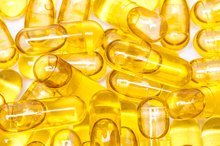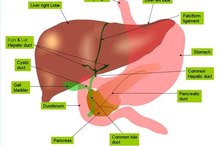Side Effects of the CLA Dietary Supplement
CLA, or conjugated linoleic acid, is another form of the omega-6 fatty acid linoleic acid found in trace amounts in some meat and dairy products. CLA is formed within the digestive systems of grazing animals, such as grass-fed cows and sheep, according to Health Services at Columbia University. It is considered safe when ingested from natural sources. There are different types, or isomers, of CLA. Dietary supplements sold as aids for weight loss and cancer prevention typically contain more of the isomer responsible for producing side effects.
Nausea and Diarrhea
Taking CLA dietary supplement in the recommended doses appears to be safe. However, the use of these supplements can produce some mild side effects in some people, such as fatigue and stomach upset, according to Memorial Sloan-Kettering Cancer Center. The gastrointestinal side effects can be reduced by taking the supplement with a meal and slowly increasing the dosage over time. CLA dietary supplements should not be taken by women who are pregnant or breastfeeding.
- Taking CLA dietary supplement in the recommended doses appears to be safe.
- The gastrointestinal side effects can be reduced by taking the supplement with a meal and slowly increasing the dosage over time.
High Blood Sugar
Gallbladder Disease and Fatigue
Learn More
Diabetics and those at risk for developing metabolic syndrome should only take CLA supplements under the supervision of a physician. CLA may help reduce body fat, but at the same cause the liver to become more fatty, leading to insulin resistance. Memorial Sloan-Kettering Cancer Center states some forms of CLA can cause hyperglycemia, or elevated blood glucose levels. This results from the body becoming resistant to the effects of the hormone insulin, which is responsible for moving glucose from the bloodstream into the cells to be used as energy.
- Diabetics and those at risk for developing metabolic syndrome should only take CLA supplements under the supervision of a physician.
- CLA may help reduce body fat, but at the same cause the liver to become more fatty, leading to insulin resistance.
Allergic Reaction
It is possible to suffer an allergic reaction to some CLA dietary supplements, according to eMedTV. The symptoms of an allergic reaction include the development of itching, a skin rash and hives, along with difficulty breathing and swallowing and swelling of the face, mouth and tongue. Any signs of an allergic reaction should be reported to a health professional immediately, and use of the supplements should be discontinued. CLA dietary supplements are not regulated as drugs by the U.S. Food and Drug Administration, so they are not tested for safety and effectiveness.
- It is possible to suffer an allergic reaction to some CLA dietary supplements, according to eMedTV.
- CLA dietary supplements are not regulated as drugs by the U.S. Food and Drug Administration, so they are not tested for safety and effectiveness.
Increase in C-Reactive Protein
Side Effects of Tonalin
Learn More
Some types of CLA found in dietary supplements may cause an increase in the levels of C-reactive protein, according to eMedTV. C-reactive protein, also known as CRP, is a protein produced by the liver, and the levels of C-reactive protein rise during widespread inflammation. C-reactive protein has been shown to play a role in the formation of blood clots and atherosclerosis, according to the Cleveland Clinic. Elevated levels of C-reactive protein can indicate an increased risk for heart attack and stroke, so those with heart disease should not take CLA dietary supplements without first consulting a physician.
- Some types of CLA found in dietary supplements may cause an increase in the levels of C-reactive protein, according to eMedTV.
- C-reactive protein has been shown to play a role in the formation of blood clots and atherosclerosis, according to the Cleveland Clinic.
Related Articles
References
Writer Bio
Kathryn Meininger began writing and publishing poetry in 1967. She was co-founder and editor of the professional magazine "Footsteps" and began writing articles online in 2010. She earned a Doctor of Podiatric Medicine from Temple University School of Podiatric Medicine and a Bachelor of Arts in biology from William Paterson University.









